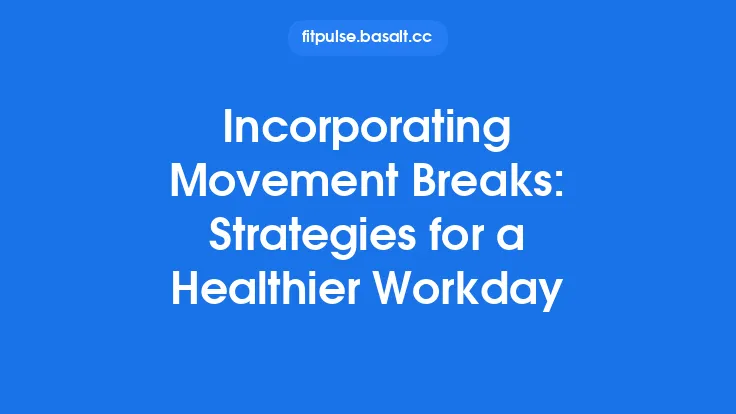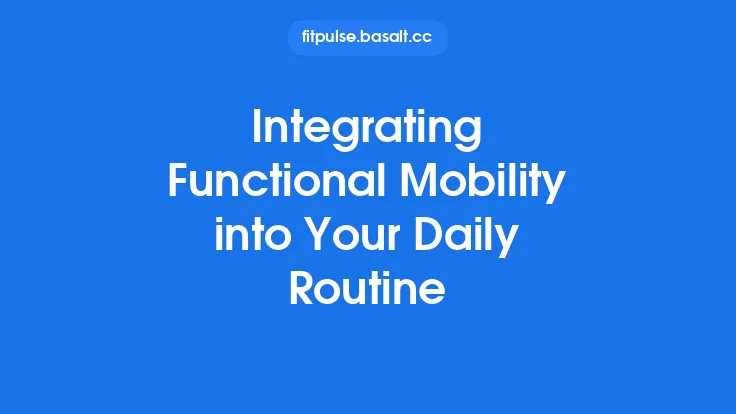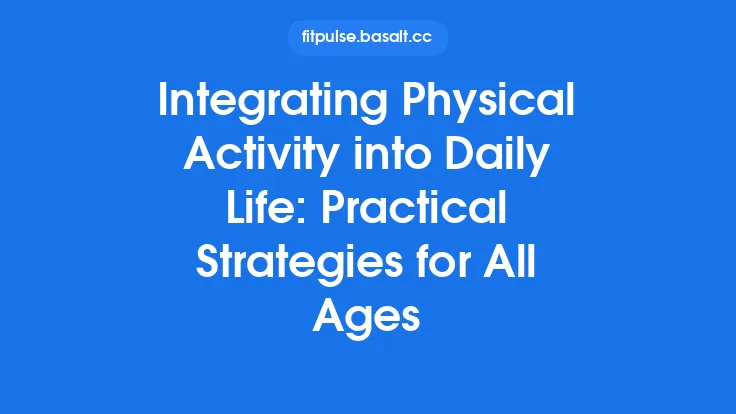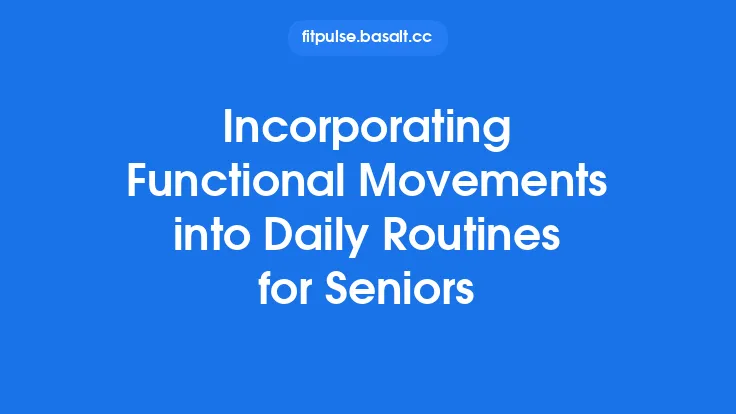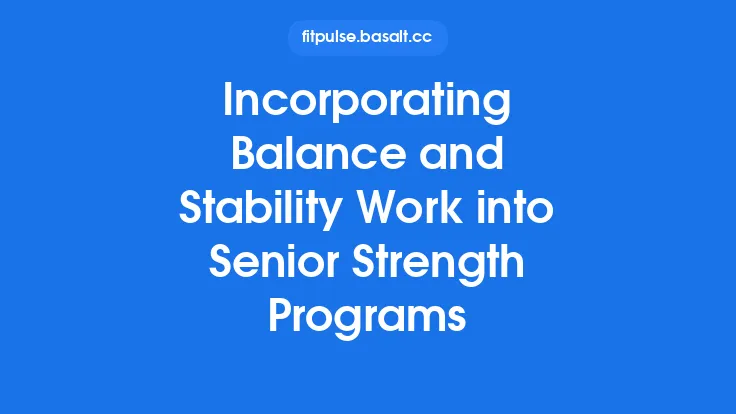In today’s office culture, the typical workday often consists of long periods of sitting at a computer, punctuated only by occasional trips to the printer or a brief coffee run. While this pattern may feel efficient, it places the body under a unique set of stresses that can erode health, productivity, and overall well‑being over time. Incorporating intentional movement breaks—short, purposeful bouts of activity performed throughout the day—offers a practical, evidence‑based solution that aligns seamlessly with the demands of desk‑based jobs. Below, we explore the scientific rationale, design principles, and implementation strategies that enable individuals and organizations to embed movement into the workday without sacrificing performance.
Why Movement Breaks Matter
The modern office environment is built around the concept of “stationary productivity.” Yet, research across occupational health, ergonomics, and physiology consistently demonstrates that prolonged static postures are linked to musculoskeletal discomfort, reduced metabolic health, and diminished cognitive function. Movement breaks serve as a counterbalance, providing intermittent relief from the physiological strain of sitting while simultaneously stimulating neural pathways that support focus and creativity.
Key points to consider:
- Risk mitigation – Regularly interrupting sitting time reduces the incidence of lower‑back pain, neck strain, and repetitive‑stress injuries.
- Metabolic health – Brief bouts of activity help maintain glucose regulation and lipid metabolism, lowering the risk of insulin resistance and cardiovascular disease.
- Cognitive performance – Light physical activity increases cerebral blood flow and neurotransmitter release, which can sharpen attention, memory, and problem‑solving abilities.
- Employee satisfaction – Workers who feel their employer supports health‑promoting practices report higher morale and lower turnover intentions.
Physiological Benefits of Regular Activity
Musculoskeletal Relief
Sitting for extended periods leads to adaptive shortening of hip flexors, weakening of gluteal muscles, and compression of intervertebral discs. A 5‑minute standing or dynamic stretch break can:
- Re‑lengthen tight hip flexors.
- Reactivate gluteal and core stabilizers.
- Relieve disc pressure through subtle spinal decompression.
Cardiovascular and Metabolic Effects
Even low‑intensity movement—such as marching in place or gentle calf raises—elicits a modest increase in heart rate (≈ 30–50% of maximal). This “light‑intensity” stimulus:
- Promotes endothelial function.
- Enhances insulin sensitivity.
- Facilitates lipid turnover, contributing to a healthier lipid profile over time.
Neurological Activation
Movement triggers the release of brain‑derived neurotrophic factor (BDNF) and catecholamines (dopamine, norepinephrine). These neurochemicals:
- Boost alertness.
- Support synaptic plasticity.
- Reduce perceived mental fatigue.
Understanding the Desk‑Based Work Environment
Before designing a movement‑break protocol, it is essential to map the typical workflow:
- Task clusters – Identify periods of deep focus (e.g., data analysis, writing) versus routine tasks (e.g., email triage).
- Physical layout – Note the distance to common resources (printer, water cooler, break area) and any obstacles (cables, narrow aisles).
- Organizational rhythm – Recognize scheduled meetings, client calls, and peak productivity windows.
A nuanced understanding of these variables allows movement breaks to be timed and placed where they cause minimal disruption and maximal benefit.
Designing Effective Movement Breaks
Core Design Principles
| Principle | Description | Practical Example |
|---|---|---|
| Specificity | Choose movements that target the postural deficits most common in desk work (hip flexor tightness, thoracic kyphosis, wrist strain). | Seated thoracic extensions, standing hip flexor stretch. |
| Progression | Start with brief, low‑intensity actions and gradually increase duration or complexity as tolerance builds. | Week 1: 30‑second standing march; Week 4: 60‑second dynamic lunges. |
| Simplicity | Use movements that require no equipment and can be performed in a typical office space. | Desk push‑ups, wall slides, ankle pumps. |
| Frequency | Align breaks with natural work cycles (e.g., every 60–90 minutes) to avoid cognitive overload. | 2‑minute break after each 90‑minute focus block. |
| Integration | Pair movement with existing micro‑tasks (e.g., walking to the printer) to reinforce habit formation. | Perform calf raises while waiting for a print job. |
Movement‑Break Templates
- Micro‑Mobility Circuit (2 minutes)
- 30 s seated spinal twist (each side)
- 30 s standing calf raise series
- 30 s desk‑level shoulder roll
- 30 s hip flexor stretch (alternating legs)
- Dynamic Reset (3 minutes)
- 1 min brisk walk around the office perimeter
- 30 s wall‑supported squat
- 30 s standing chest opener (hands clasped behind back)
- 1 min “desk‑to‑door” step‑ups (use a low step or sturdy box)
- Focused Activation (1 minute)
- 20 s scapular retractions (standing, elbows bent, squeeze shoulder blades)
- 20 s seated ankle circles (each direction)
- 20 s neck lateral stretch (gentle tilt, hold each side)
These templates can be mixed, rotated, or customized based on individual needs and office constraints.
Timing and Frequency: Evidence‑Based Recommendations
Research on sedentary behavior suggests a “dose‑response” relationship: the more frequently sitting is interrupted, the greater the health benefit. While exact numbers vary across studies, a pragmatic guideline for desk‑based professionals is:
- Every 60 minutes: Stand or move for 2–3 minutes.
- Every 90 minutes: Perform a full‑body activation sequence lasting 3–5 minutes.
- During natural pauses (e.g., waiting for a meeting to start, phone on hold): Add 10–30 seconds of light movement.
Implementing a tiered approach—short micro‑breaks interspersed with occasional longer activation sessions—optimizes both physiological recovery and workflow continuity.
Practical Movement Break Routines
Routine A: “The Quick Reset” (1‑minute)
- Stand up (if seated).
- March in place for 20 seconds, lifting knees to a comfortable height.
- Shoulder rolls: 10 forward, 10 backward.
- Desk‑level hamstring stretch: place one heel on the floor, gently lean forward, hold 10 seconds each side.
Ideal for: Tight schedules, back‑to‑back meetings, or when a phone call is on hold.
Routine B: “The Mid‑Day Recharge” (4‑minute)
- Walk to a window (or around the office) for 60 seconds, focusing on deep breathing.
- Wall slide: Stand with back against wall, arms at 90°, slide up and down for 30 seconds.
- Standing hip flexor stretch: 30 seconds each side, hands on hips, gently push pelvis forward.
- Desk push‑ups: 10–12 repetitions, hands on desk edge, elbows at 45°.
- Return to workstation, sit down, and take a moment to re‑center focus.
Ideal for: Lunch‑time or after a prolonged analytical task.
Routine C: “The End‑of‑Day Wind‑Down” (3‑minute)
- Neck mobility: slow side‑to‑side and up‑down rotations, 10 seconds each direction.
- Seated cat‑cow: alternate spinal flexion and extension while seated, 30 seconds.
- Ankle pumps: 30 seconds, alternating dorsiflexion and plantarflexion.
- Deep breathing: 1‑minute diaphragmatic breathing, inhaling for 4 seconds, exhaling for 6 seconds.
Ideal for: Reducing accumulated tension before leaving the office.
Integrating Breaks into Workflow Without Disruption
- Leverage natural transition points – Use the moment you finish a task, before starting a new one, as a cue for a movement break.
- Pair with technology cues – Simple timers, calendar alerts, or desktop widgets can serve as non‑intrusive reminders.
- Batch similar tasks – Group email checks or data entry into blocks, allowing a longer movement break between batches.
- Communicate expectations – Let teammates know you’ll be stepping away briefly; this normalizes the practice and reduces perceived “lost time.”
- Use standing or adjustable desks – Even a brief shift to a standing position counts as a break from static sitting.
Tools and Environmental Supports
- Adjustable workstations – Height‑adjustable desks enable quick transitions between sitting and standing.
- Floor markers – Small visual cues (e.g., a colored mat) can remind you to perform a specific stretch when you step onto it.
- Desk‑friendly equipment – Resistance bands, a small foam roller, or a balance cushion can add variety without clutter.
- Software plugins – Lightweight applications that dim the screen or display a subtle animation every hour can act as a gentle nudge.
- Shared spaces – Designate a “movement corner” with a wall mirror, a yoga mat, or a low step for quick activation.
These tools should be viewed as facilitators, not prerequisites; the core principle is that movement can be performed with minimal or no equipment.
Monitoring Progress and Adjusting the Plan
To ensure the movement‑break program remains effective, adopt a simple feedback loop:
- Baseline assessment – Record initial metrics: self‑reported discomfort (e.g., on a 0‑10 scale), number of hours seated per day, and any objective data (e.g., step count from a wearable).
- Weekly check‑ins – Note changes in discomfort, energy levels, and productivity. Use a brief journal or digital form.
- Quantitative tracking – If a wearable is available, monitor “active minutes” that occur outside of formal exercise sessions.
- Iterative refinement – Adjust break frequency, duration, or movement selection based on the data. For example, if lower‑back pain persists, increase hip‑flexor and glute activation exercises.
- Long‑term review – Every 3–6 months, compare baseline and current data to evaluate overall impact and decide whether to scale the program organization‑wide.
Overcoming Common Barriers
| Barrier | Practical Solution |
|---|---|
| Perceived loss of work time | Emphasize that brief breaks improve focus, leading to faster task completion. Use a “focus‑recovery” model: 90 min work → 2‑min break → higher output. |
| Lack of space | Choose movements that stay within the workstation footprint (e.g., seated stretches, desk push‑ups). |
| Social stigma | Lead by example; encourage managers to model the behavior. Create a “movement‑break buddy” system for mutual accountability. |
| Forgetfulness | Set recurring calendar events or use a discreet desktop notification. |
| Physical limitations | Offer low‑impact alternatives (e.g., seated ankle circles, seated torso twists) and encourage consultation with occupational health if needed. |
Organizational Policies and Culture
Embedding movement breaks into the fabric of an organization requires more than individual effort. Consider the following policy levers:
- Official break guidelines – Include movement‑break recommendations in employee handbooks or wellness policies.
- Leadership endorsement – Executives who visibly take breaks set a cultural precedent.
- Dedicated spaces – Allocate a small area for stretching or light activity, equipped with a mirror and a few mats.
- Incentive programs – Recognize teams that consistently log movement breaks or report reduced musculoskeletal complaints.
- Training sessions – Offer short workshops on ergonomics and movement‑break techniques during onboarding or quarterly health weeks.
When policies align with daily practice, the adoption rate rises dramatically, and the health benefits become a shared organizational asset.
Case Examples from Different Industries
1. Financial Services – “The Desk‑to‑Desk Walk”
A mid‑size investment firm introduced a “walk‑to‑desk” protocol: after every 90‑minute analytical session, analysts walked to a designated “focus station” across the floor for a 2‑minute stretch routine. Within three months, reported lower‑back pain decreased by 27%, and average time to complete report drafts improved by 12%.
2. Software Development – “Code‑Break Sprints”
A tech startup integrated a 3‑minute “code‑break sprint” into its agile workflow. At the end of each 2‑hour coding block, developers performed a quick circuit of standing hip flexor stretches, wrist extensions, and neck rotations. The practice correlated with a 15% reduction in reported eye strain and a measurable increase in code‑review quality scores.
3. Healthcare Administration – “Shift‑Change Mobility”
A hospital administration department instituted a 5‑minute mobility session at the start of each shift change. Staff performed a series of wall slides, calf raises, and deep breathing exercises. Over six months, absenteeism due to musculoskeletal complaints dropped by 18%, and staff satisfaction survey scores rose by 9 points.
These examples illustrate that movement‑break strategies can be tailored to diverse work contexts while delivering measurable outcomes.
Future Directions and Research Gaps
While the benefits of interrupting sedentary time are well documented, several areas warrant further investigation to refine movement‑break programming:
- Optimal dose‑response curves – Determining the precise combination of frequency, duration, and intensity that maximizes health outcomes without compromising work output.
- Neurocognitive impact – Longitudinal studies linking movement‑break frequency to specific cognitive domains (e.g., working memory, creative problem‑solving).
- Personalization algorithms – Leveraging wearable data and machine‑learning models to suggest individualized break schedules based on real‑time posture and fatigue metrics.
- Organizational economics – Quantifying the return on investment (ROI) of movement‑break policies in terms of reduced healthcare costs, lower turnover, and increased productivity.
- Cross‑cultural applicability – Exploring how cultural attitudes toward work breaks influence adoption and effectiveness across global workforces.
Advancements in these areas will enable more precise, data‑driven integration of movement into the modern office.
Conclusion
Movement breaks are a low‑cost, high‑impact intervention that directly addresses the physiological and cognitive challenges inherent in desk‑based work. By grounding break design in scientific principles—targeting postural imbalances, supporting metabolic health, and enhancing neural activation—individuals can experience tangible improvements in comfort, focus, and overall well‑being. Successful implementation hinges on thoughtful timing, simplicity of movements, and alignment with existing workflow patterns. When organizations champion these practices through supportive policies, environmental adaptations, and cultural endorsement, the benefits extend beyond the individual to the entire workplace ecosystem.
Incorporating regular, purposeful movement into the workday is not a luxury; it is an essential component of sustainable, high‑performing professional life. By embracing the strategies outlined above, both employees and employers can create a healthier, more resilient, and more productive office environment—one active pause at a time.
